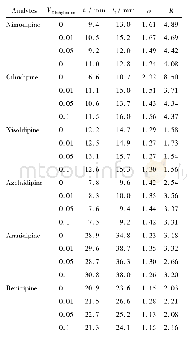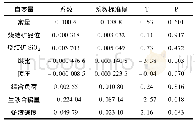《Table 1–Effect of various ligands on the adsorption percentages of the adsorbents.》
 提示:宽带有限、当前游客访问压缩模式
提示:宽带有限、当前游客访问压缩模式
本系列图表出处文件名:随高清版一同展现
《"Carboxymethyl cellulose thiol-imprinted polymers:Synthesis, characterization and selective Hg(Ⅱ) adsorption"》
Sulfur IIPs(S-IIPs)functionalized with cysteamine(CS)were found to possess the highest adsorption percentage compared to cysteamine HCl(CS·HCl)functionalized S-IIPs and 5 amino-1,3,4-thiadiazole-2-thiol(ATT)functionalized S-IIPs(Table 1).On the other hand,Appendix A Fig.S1 which shows a type IV isotherm with hysteresis loops at relative pressures of between 0.8 and 1 for CS·HCl and ATT IIPs,signifies the presence of mesopores in the polymers(Fu et al.,2016;Meouche et al.,2017).S-IIPs functionalized with ATT gave the lowest adsorption percentage because,being cyclic(Appendix A Fig.S2),this compound seems too bulky to fit in the matrices of the polymer.The low adsorption percentage associated with the cysteamine hydrochloride(CS·HCl)functionalized S-IIPs is attributable to the hydrochloride moiety,which prevents the amine groups from reacting with the carboxylic functionalities,thus inhibiting the formation of the crucial amide bond(Luong et al.,2015).Additionally,as indicated in Table 1,IIPs with CS were found to possess the highest surface area compared to ATT functionalized S-IIPs and CS·HCl functionalized S-IIPs.It is for this reason that CS was adopted in this study for the synthesis of NIPs and S-IIPs.
| 图表编号 | XD0052062300 严禁用于非法目的 |
|---|---|
| 绘制时间 | 2019.05.15 |
| 作者 | Tarisai Velempini、Kriveshini Pillay、Xavier Y.MbiANDa、Omotayo A.Arotiba |
| 绘制单位 | Department of Applied Chemistry, University of Johannesburg, Doornfontein Campus、Department of Applied Chemistry, University of Johannesburg, Doornfontein Campus、Centre for Nanomaterials, University of Johannesburg, Doornfontein Campus、Department of Scien |
| 更多格式 | 高清、无水印(增值服务) |
查看“Table 1–Effect of various ligands on the adsorption percentages of the adsorbents.”的人还看了
-

- Table 2 Influence of different percentages of alkaline additives on the chiral separation of dihydropyridine calcium ant
-

- Table 1 Influence of different percentages of polar modifier on the enantioseparation of dihydropyridine calcium antagon





